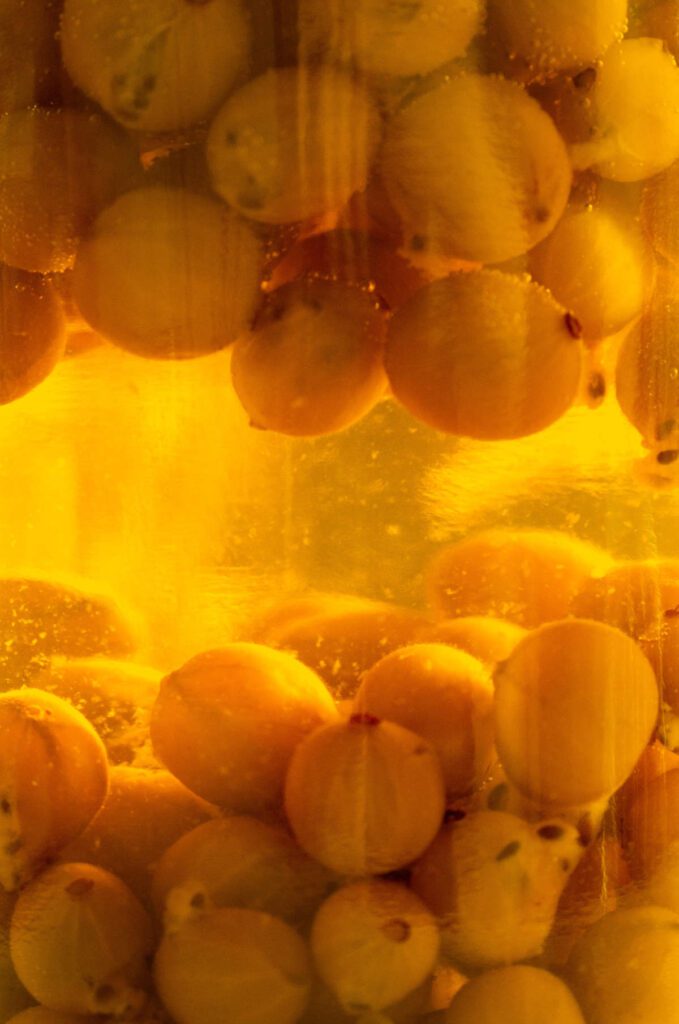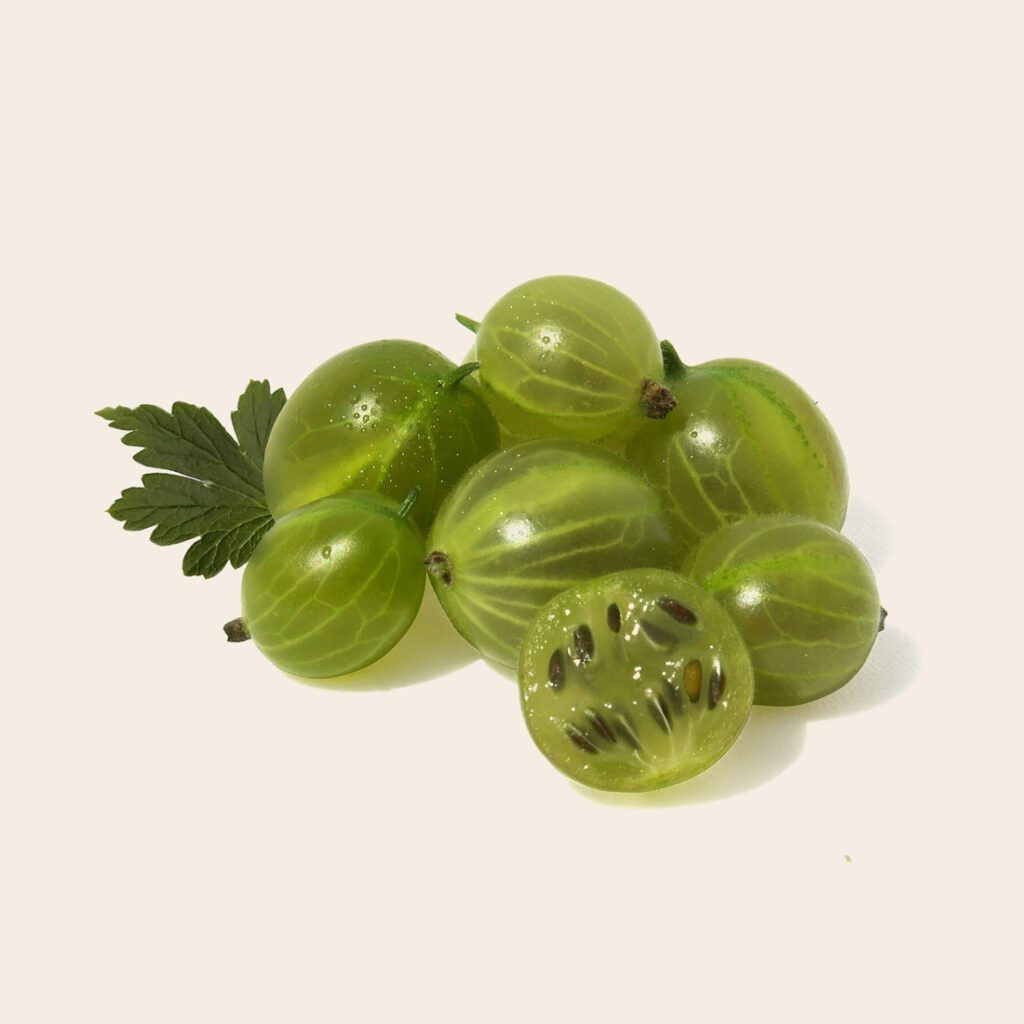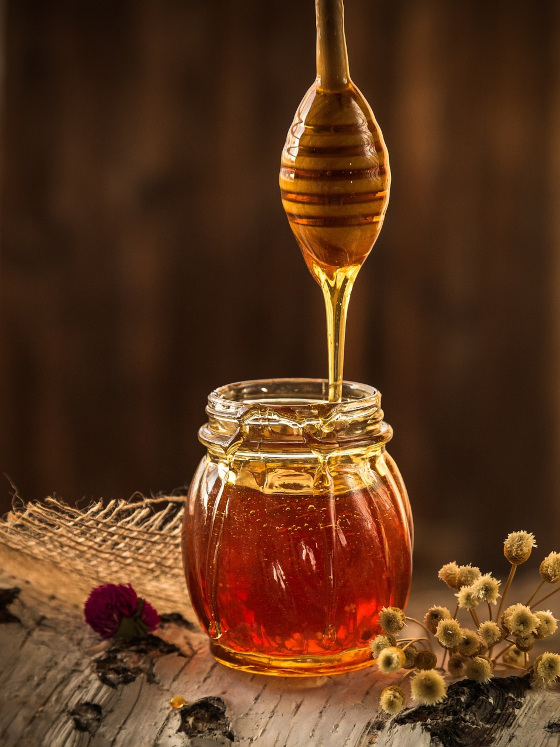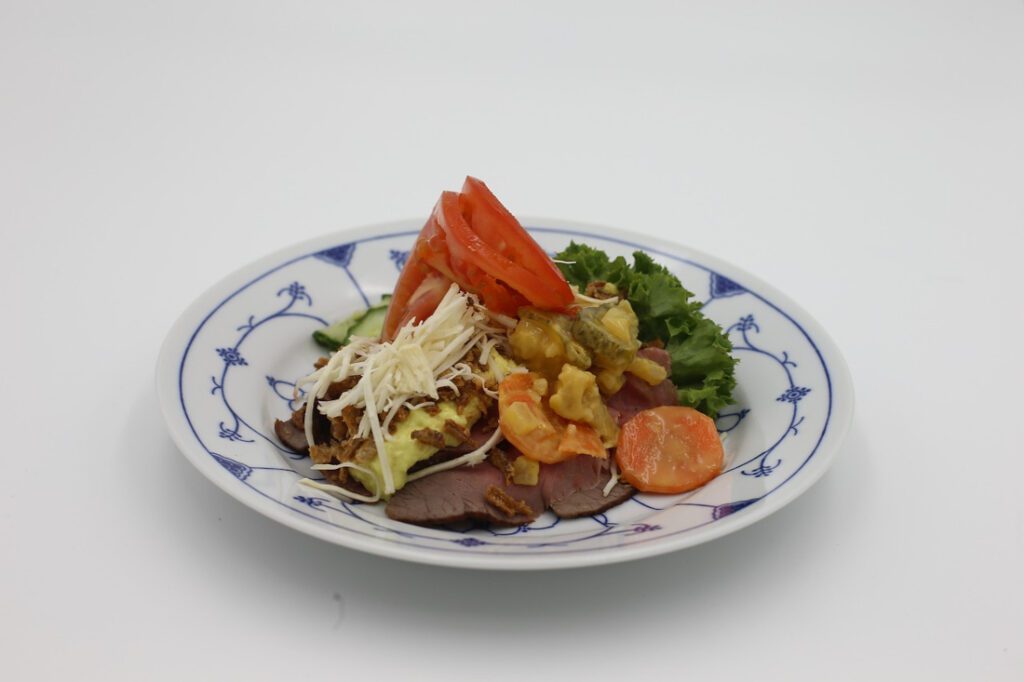Pickled gooseberries may seem like an odd preserve to make, but they are a great way to bring some zing and flavour to salads, sauces, and other dishes. Plus, pickling is a super simple process that can turn any fruit or vegetable into something special.
The gooseberry season is a short one, from June till August, if you are so lucky. Having these delightful and distinctive berries available for a brief time means that you should have an arsenal of recipes that you can use them in. This way you can enjoy them both in season as well as extending their delight for longer too.

In this blog post recipe, I describe how easy it is to make delicious pickled gooseberries. And there is no fancy equipment required too! With a few ingredients, you can create a unique pickle that will enhance the flavours of any dish.
Explore pickles gooseberries
• Pickled gooseberries are a unique and tasty way to enjoy the tart flavour of fresh berries.
• Their pickling process ensures that they can be stored for longer periods. This makes them an ideal ingredient for meal planning or preserving seasonal produce.
• The seasoned brine adds an extra dimension of flavour. This comes from the combination of savoury spices like ginger and cloves to sweeteners such as sugar, or honey.
• Pickled gooseberries also offer health benefits due to their high concentrations of antioxidants and vitamins A and C. These are thought to provide some anti-inflammatory protection.
The pickling of gooseberries

Making pickled gooseberries is a relatively straightforward process that yields a delicious, tangy treat. First, the gooseberries should be washed and drained of excess water. The ginger and spices are prepared.
Next, add the vinegar, sugar, salt and spices to a pan and bring it to a boil. Turn the heat down and add the lemon juice and gooseberries. Allow them to simmer on low for a few minutes.
Gently pack the gooseberries into your prepare jars, fish out the spices and add them to the jars too.
Pour the hot brine into the jars, completely submerge the berries, and seal.
Finally, the jar should be left in a cool place for around 1-2 weeks (or longer) for the blending and mellowing of the flavours to take place. During this time, the acidic liquid will work its magic, turning the berries into a flavorful pickle that can hold its own as part of your next meal.
TIPS
1. Start by purchasing or picking the best-quality fresh gooseberries you can find. Make sure that they are firm and well-shaped. You can use both green and/or red gooseberries.

I would advise against using frozen or tinned gooseberries as both processes have already resulted in softening the gooseberries a lot and they are very likely to just break down completely if subject to pickling as described in this recipe.
2. Use vinegar with a 5% acetic acid content. With this criterion met, you could choose between distilled white wine vinegar, red wine vinegar or apple cider vinegar for the pickling liquid.
3. Make sure to heat your brine solution to boiling point before submerging the berries in it; this will help ensure an element of sterilization of the fruit and limit spoilage.
4. Add your favourite herbs, spices, onion slices or garlic cloves to give your pickled gooseberries even more flavour and make them more interesting. Use the zest of the lemon too for s sharper taste note. Experiment until you get it just how you like it!
Flavour options for pickled gooseberries
1. Vary the vinegar for the pickling liquid, or make a blend of different kinds of vinegar (with 5% acetic acid) for a unique flavour.

2. Experiment with different spices like star anise, cardamom, bay leaves, and more to create a distinctive taste profile.
3. Add sweeteners like honey or agave to add more depth of flavour and balance out the spiciness of some ingredients in your recipe.
4. Try some dried chilli flakes or a fresh chilli split open for as much or as little heat and complexity.
5. Infuse herbs into the brine such as rosemary, thyme or tarragon for aroma and herby layers of flavoursome goodness!
Uses for pickled gooseberries
Use as a condiment
The unique tart-sweet taste of pickled gooseberries makes it perfect for use as an accompaniment to savoury dishes such as grilled meats, fish, stews and other cooked items. It is especially good with oily, rich fish such as mackerel and meat like pork, lamb or game.
Include in salads

Gooseberry pickles can be added to leafy greens for a taste sensation like no other!
Add to a cocktail
Instead of an olive, add a pickled gooseberry to your next martini for something special!
Serve on cheese boards
Pickled gooseberries pair perfectly with strong cheeses like blue since their sweet-tart notes cut through the bold flavours of the cheese while still complementing its richness nicely.
Use in sauces
Whether you’re making a BBQ sauce or béarnaise, adding some finely chopped pickled gooseberries will add another dimension of flavour that cannot be missed!
Pickled gooseberries are an interesting and unique way to enjoy this tart fruit. Preserving them in spiced vinegar is another way to preserve their flavour while adding some extra zing. With just a few ingredients and little effort, it yields maximum flavour.
Tangy spiced gooseberries add a fun twist that will delight all who try them. Try out this simple yet scrumptious recipe today and experience the unforgettable taste of pickled gooseberries!

Recipe for Making Pickled Gooseberries
Equipment
- Kitchen scales
- Chopping board and knife
- Preserving pan or large saucepan
- Long-handled spoon for stirring
- Slotted spoon
- Ladle
- Funnel
- Clean, sterilised glass jars with non-reactive lids
Ingredients
- 300 g gooseberries
- 2 cm ginger
- 225 ml white wine vinegar
- 35 g sugar
- ¼ tsp mustard seeds
- ¼ tsp salt
- ¼ tsp peppercorns
- 4 cloves
Instructions
- Wash the gooseberries and let them dry on a tray lined with kitchen paper. Then top-and-tail the fruits, without damaging them. Discard any blemished berries.
- Peel the piece of ginger and cut this into match-sticks.
- In a large pot on medium-high heat, bring the vinegar, ginger, sugar, spices and salt to a boil. Stir until everything is dissolved.
- Turn down the heat and simmer for 5 minutes.
- Add the gooseberries and lemon juice to the pot and simmer for another 10 minutes, stirring occasionally and gently.
- Use the slotted spoon to lift out the gooseberries and add them to the prepared warm jars. Scoop out the spices and divide them between the jars.
- Pour the pickling mixture over the berries, making sure to cover them with the liquid.
- Seal with non-reactive lids and leave, at room temperature, to cool completely.
- Leave to mature for 7 days (or more) before enjoying. Could last for up to 3 months in a cool, dark place. The gooseberries will soften more over time.
- Once open, store it in the fridge.
- Refrigerate for at least 24 hours before serving. Enjoy.
Notes
TIPS
1. Start by purchasing or picking the best-quality fresh gooseberries you can find. Make sure that they are firm and well-shaped. You can use both green and/or red gooseberries. I would advise against using frozen or tinned gooseberries as both processes have already resulted in softening the gooseberries a lot and they are very likely to just break down completely if subject to pickling as described in this recipe. 2. Use vinegar with a 5% acetic acid content. With this criterion met, you could choose between distilled white wine vinegar, red wine vinegar or apple cider vinegar for the pickling liquid. 3. Make sure to heat your brine solution to boiling point before submerging the berries in it; this will help ensure an element of sterilization of the fruit and limit spoilage. 4. Add your favourite herbs, spices, onion slices or garlic cloves to give your pickled gooseberries even more flavour and make them more interesting. Use the zest of the lemon too for s sharper taste note. Experiment until you get it just how you like it!Flavour options for pickled gooseberries
1. Vary the vinegar for the pickling liquid, or make a blend of different kinds of vinegar (with 5% acetic acid) for a unique flavour. 2. Experiment with different spices like star anise, cardamom, bay leaves, and more to create a distinctive taste profile. 3. Add sweeteners like honey or agave to add more depth of flavour and balance out the spiciness of some ingredients in your recipe. 4. Try some dried chilli flakes or a fresh chilli split open for as much or as little heat and complexity. 5. Infuse herbs into the brine such as rosemary, thyme or tarragon for aroma and herby layers of flavoursome goodness!Uses for pickled gooseberries
Use as a condiment
The unique tart-sweet taste of pickled gooseberries makes it perfect for use as an accompaniment to savoury dishes such as grilled meats, fish, stews and other cooked items. It is especially good with oily, rich fish such as mackerel and meat like pork, lamb or game.Include in salads
Gooseberry pickles can be added to leafy greens for a taste sensation like no other!Add to a cocktail
Instead of an olive, add a pickled gooseberry to your next martini for something special!Serve on cheese boards
Pickled gooseberries pair perfectly with strong cheeses like blue since their sweet-tart notes cut through the bold flavours of the cheese while still complementing its richness nicely.Use in sauces
Whether you’re making a BBQ sauce or béarnaise, adding some finely chopped pickled gooseberries will add another dimension of flavour that cannot be missed!Nutrition
Nutritional Disclaimer
All nutritional information is an estimate only, based on third-party calculations derived from an online nutritional calculator, Spoonacular API. The data provided is a courtesy and should not be considered a guarantee or fact. Each recipe and nutritional value will vary depending on the ingredients and brands you use, your measuring methods and portion sizes. For accurate results, we recommend that you calculate the nutritional information yourself, using a preferred nutritional calculator or advice from a nutritionist, based on your ingredients and individual processes.